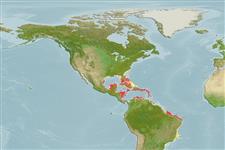Common names from other countries
Environment: milieu / climate zone / depth range / distribution range
Écologie
Récifal; saumâtre; profondeur 2 - 60 m (Ref. 108813). Tropical
Western Atlantic.
Length at first maturity / Taille / Poids / Âge
Maturity: Lm ? range ? - ? cm
Description synthétique
Morphologie
Growth forms varies from thick encrustations more than 1 cm thick, to irregular interconnected encrusting lobes, globular masses, fused groups of conical to chimney-like tubes, or irregular branches reaching 35 cm in height and 3 cm in width. Surface either smooth and finely porous with many fine perforations, or finely rugose. May also be slimy and corrugated out of water. Exterior is commonly orange-brown, but may also be yellow-orange, orange, yellowish-brown or red-orange. Yellow to cream interior. Firm and brittle consistency. Mucus exudate rare. Oscules flush or elevated on conical lobes or tubes with a yellow collar membrane, may be evenly spaced, scattered, or in rows that fuse together into low ridges. May be surrounded by fine radiating grooves (Ref. 85482).
Maximum depth reported taken from Ref. 128739. Occurs on coral reefs, hard bottoms, lagoons (Ref. 85482), and mangroves (Ref. 86836). It hosts alpheid shrimps in its canals (Ref. 83410). Inhabits coralline algae reefs, coral communities, algal nodules, shallow coral and lower mesophotic reefs (Ref. 128739).
Life cycle and mating behavior
Maturité | Reproduction | Frai | Œufs | Fécondité | Larves
Members of the class Demospongiae are hermaphroditic. Life cycle: The zygote develops into parenchymella larva (free-swimming) before settling down on a substrate where it grows into a young sponge.
Engel, S. and J.R. Pawlik. 2005. (Ref. 837)
Statut dans la liste rouge de l'IUCN (Ref. 130435)
statut CITES (Ref. 108899)
Not Evaluated
Not Evaluated
Utilisations par l'homme
| FishSource |
Outils
Plus d'informations
Taille/ÂgeCroissanceLongueur-poidsLongueur-longueurMorphologieLarvesAbondance
Sources Internet
Estimates based on models
Preferred temperature
(Ref.
115969): 24.8 - 28.2, mean 27.3 (based on 519 cells).
Catégorie de prix
Unknown.
